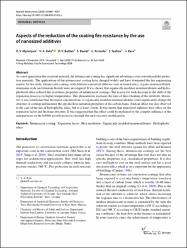Aspects of the reduction of the coating fire resistance by the use of nanosized additives

View/
Date
2020Author
Myronyuk, O. V.Raks, V. A.
Baklan, D. V.
Barrat, S.
Arranda, L.
Yezhov, S.
Kara Subaşat, Hülya
Metadata
Show full item recordAbstract
As a new generation fire-resistant material, the intumescent coating has significant advantages over conventional fire protection materials. The applications of the intumescent coating have changed widely and have dominated the fire engineering market. In this study, intumescent coatings with different nanosized additives such as fumed silica, organo-montmorillonite, aluminum oxide and titanium dioxide were investigated. It was shown that organically modified montmorillonite and hydrophobized silica reduced fire resistance properties of intumescent coatings. The reason for such decrease is the shift of the expansion processes to higher temperatures. This phenomenon increases the time of direct heating of the substrate. Moreover, it was established that the minor concentrations of organically modified montmorillonite could significantly change the structure of coatings and increase the specific heat insulation properties of the carbon foams. Such an effect was also observed in the case of the use of hydrophobic silica, but to a lesser extent. It was shown that nanosized additives have effect on the expansion factor and the foam structure. It was suggested that this effect could be explained by the complex influence of the nanoparticles on the bubble growth processes through the melt viscosity modification.

















